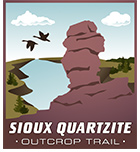At this site you’ll find a quartzite outcropping cliff, ranging from 10 to 15 feet in height, that runs the entire length of the 301-acre site. Beneath the quartzite is pipestone, this stone is sacred to American Indians and they have been quarrying the area for generations.
Located in Pipestone County, the state park is home to a dam and a stone bridge that were both constructed with Sioux quartzite. The craftsmanship of the bridge has earned it a spot on the National Register of Historic Places. Here you’ll also find lots of other great outdoor activities.
As one of the most picturesque and unique areas inn South Dakota, Palisades State Park is a popular destination for travelers. Here you’ll find Sioux quartzite formations that line Split Rock Creek and rise out of the water by as much as 50 feet in some areas. Two of the most unique formations are called King and Queen Rock.
These Sioux quartzite outcroppings are located along the James River south of Alexandria. This secondary outcropping site is the western edge of Sioux quartzite country.
Along the shores of the Saint Olaf Roller Mill you’ll see the outcropping of Sioux quartzite. The mill is located what’s known today as Baltic but at its birth, the area was St. Olaf. The mill was a nucleus for the town.
The “Three Sisters” outcroppings on the Big Sioux River are part of the Potsdam Formation of rose quartzite that runs at least 2,600 feet deep at the Dell Rapids quarries.
Redstone is located in New Ulm, MN and is part of a quarry now owned by New Ulm Quartzite Quarries. The first quarry on the site was established in 1858 by Michael Schulz of Redstone.
The outcroppings of Sioux quartzite has saved Red Rock Dells from becoming another farm to be tilled. Today you can expierence 611 acres where you’ll see a small creek that has exposed some of the Sioux quartzite, you’ll also see large gorge with a waterfall that’s more than 20 feet tall.
The Big Sioux River flows between cliffs of Sioux quartzite that reach as high as 40 feet. In the late 1800s the area offered a number of natural advantages for the development of a town. With its beauty and powerful water it initially became known as Dell City.
Scattered amid the prairie grasses are islands of Sioux quartzite outcroppings that span 23 miles, across Cottonwood County. The Red Rock Ridge is made of rock more than 1.6 billion years old. On some of the Sioux quartzite you’ll find carvings, or petrolyphs, created about 7000 years ago by American Indians.
The Sioux quartzite you’ll find here was estimated to be more than a mile thick and between 1.2 to 1.7 billion years old. In the 1880s quarries were in full swing in this area and remained active until the late 1890s. There are structures in the nearby town, Luverne, that are made from the stone from the quarries.
A project that started in 2001 by photographer and filmmaker, Jim Brandenburg, is now a prairie made up of more than 800 acres and preserved for public enjoyment. The prairie is home to a Sioux quartzite ridgeline that runs over a mile.
This city-owned park in Garretson, SD offers as much scenery as it does history. The powerful water of Split Rock Creek has carved out a deep, narrow canyon in the Sioux Quartzite rock. Legend has it, Jesse James convinced his horse to leap over the ravine to avoid capture in 1876.
A number of quarries populated this area in the 1880s and by the 1890 the largest quarry employed almost 500 men. Today this area is part of 115 acre park, a dream by local environmental advocate, Mary Jo Wegner, who fell in love with the beauty and history of the area.
The Gitchie Manitou State Preserve is located in the extreme northwestern corner of Iowa, near the South Dakota border. The preserve, covering 91 acres, is home to Precambrian Sioux Quartzite outcroppings that are about 1.6 billion years old; the oldest surface bedrock in Iowa.
The three-tiered waterfall on the Big Sioux River is what gave Sioux Falls its name. It’s now part of a 123 acre park that sees thousands of visitors each year. In 1878, construction began on the seven-story Queen Bee Mill and by 1881 the mill was complete. Richard Pettigrew understood the power offered by the falls and wanted to harness it.

Primary Outcropping

Secondary Outcropping

Primary Outcropping

Secondary Outcropping

Secondary Outcropping

Secondary Outcropping

Secondary Outcropping

Secondary Outcropping

Primary Outcropping

Primary Outcropping

Primary Outcropping

Primary Outcropping

Primary Outcropping

Primary Outcropping

Primary Outcropping

Primary Outcropping
